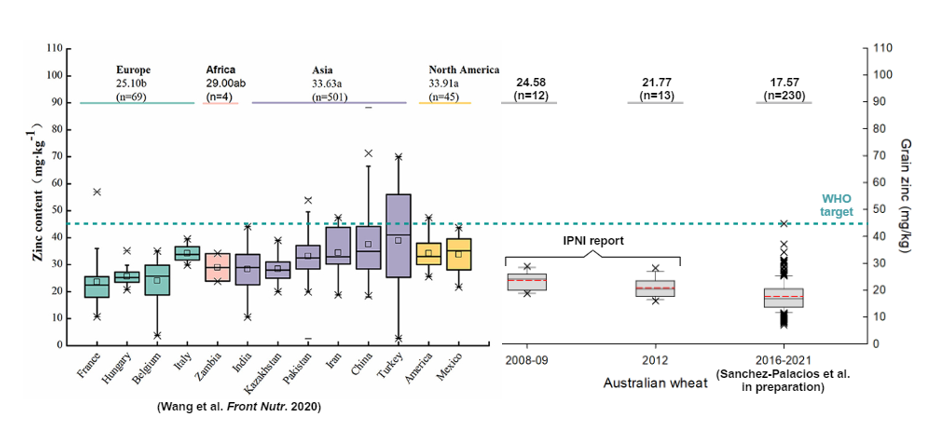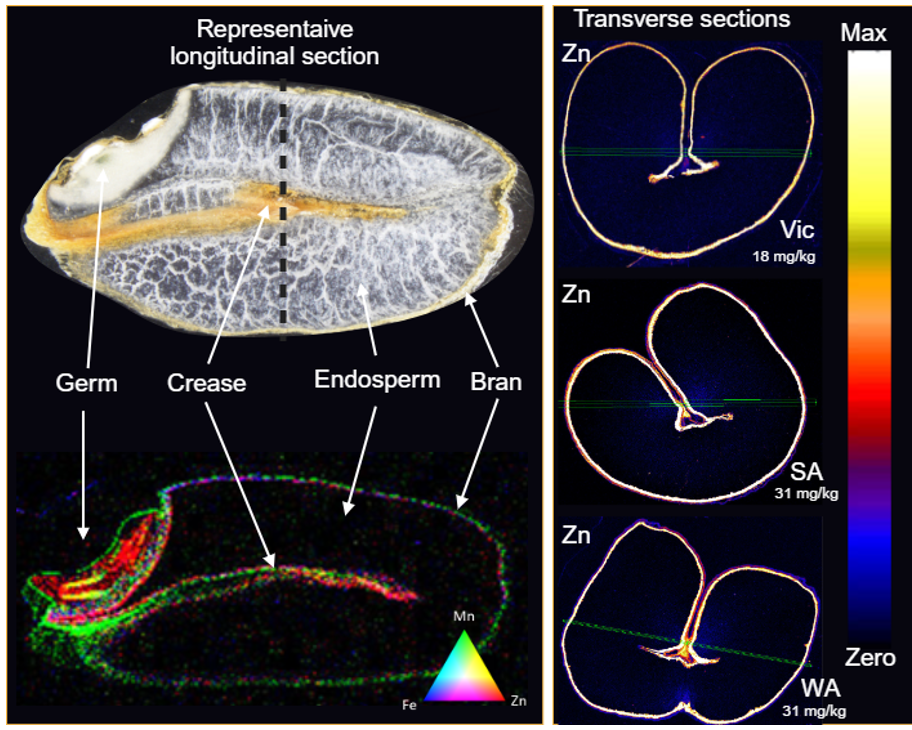Agronomic intervention to enhance the nutritional quality of Australian wheat: securing future market access
Agronomic intervention to enhance the nutritional quality of Australian wheat: securing future market access
Author: Tona Sanchez-Palacios and Richard Bell | Date: 07 Mar 2024
Key messages
- Australia's largest agricultural export commodity lacks mineral nutrient attributes for human nutrition. The mean zinc (Zn) concentration in Australian wheat grain (WA, SA, Vic) for the past five years in the wheat cultivar Scepter was below 20mg Zn/kg.
- Applying Zn-foliar products on Australian cultivated wheat plants resulted in a two-fold increase in grain Zn concentrations. This approach could be adopted in modern agricultural systems to meet future demands from international buyers for nutrient-dense grain products.
- Techniques developed at the Australian Nuclear Science and Technology Organisation (ANSTO) were used to determine the efficiency of novel foliar formulations in producing wheat grain with superior mineral nutrient attributes.
Aims
To determine the zinc concentrations in Australian wheat grains and investigate the effectiveness of conventional and novel zinc-foliar applications in increasing zinc concentrations in wheat grain.
Introduction
Wheat is one of the most produced and globally traded grains. This results from improvements in short-straw wheat cultivars and the use-efficiency of fertilisers. Historically, wheat yield remained stable at around 1t/ha until the introduction of fertilisers in 1968, which increased yield significantly. An increase in grain yield resulted in the reduction of micronutrients in grain. Studies on archived wheat grains in the UK for over 160 years show that grain Zn decreased markedly from 35mg Zn/kg to 20mg Zn/kg by the end of the 20th century (Fan et al. 2008).
The World Health Organization (WHO) recommends a target of 45mg Zn/kg in wheat grain to combat Zn deficiency globally. Records show that wheat grain in international markets falls below this target. A study by Wang et al. (2020) reported that the Zn concentration in North America, including Mexican wheat, was at 34mg Zn/kg. An equivalent level was recorded in Asia, averaging 34mg Zn/kg, including India, Kazakhstan, Pakistan, Iran, China, and Turkey. In Africa, Zambia recorded 29mg Zn/kg. European countries showed an average of 25mg Zn/kg, including France, Hungary, Belgium and Italy. International breeding programs such as HarvestPlus have improved high-yield wheat varieties with higher Zn since 2006. In 2023, HarvestPlus reported the Pakistan wheat cv. PBW Zinc-2 contained 48.5mg Zn/kg with 5.7t/ha grain yield. Russian breeding programs reported 64mg Zn/kg in wheat grain (Shamanin et al. 2021). HarvestPlus and the British Standards Institution (BSI) have proposed commercialisation standards for wheat with Zn-advantage by introducing a grading class system to accelerate the implementation and marketing of Zn-enriched wheat grains (PAS 233:2021). This approach may influence future trade decisions in export markets where Australia participates.
During 2022–23, China acquired nearly a quarter of Australia's total wheat grain exports, 32Mt. Exporters in the region will likely see significant competition from China's interest in Australian wheat. Chinese population consume nearly 20% of the global wheat production. However, the Chinese population suffers from Zn deficiency primarily in rural areas, resulting from consuming low-Zn food (Ma et al. 2008). In China, fortification food programs can only be used as a short-term approach targeting groups at risk of prevalence of Zn deficiency. Corrective agricultural methods have been considered, but evidence of effectiveness remains limited.
In recent years, there has been a lack of knowledge of Zn concentrations in Australian wheat grain exports. The International Plant Nutrition Institute (IPNI) reported 24mg Zn/kg in wheat cultivated in 70 NVT sites across NSW, SA and Vic during the 2008 and 2009 growing seasons (Norton 2013). In that report, 13 NVT sites from the 2012 growing season across NSW, SA, Vic and WA produced 21mg Zn/kg grains. Since 2013, no studies have investigated the Zn levels in popular high-yielding wheat cultivars. Therefore, we aimed to investigate the Zn concentrations in a widely grown wheat cultivar across the West and Southern regions. We implemented agronomic biofortification techniques to boost grain Zn levels. Finally, we use elemental mapping technologies to assess the effectiveness of novel foliar formulations to deliver Zn to the grain.
Method
We accessed NVT Scepter wheat grain samples from 2016, 2017, 2018, 2020 and 2021, representing different soil and environmental conditions across WA, SA, and Vic agricultural regions. Grain samples were sent to CSBP-certified analytical laboratory facilities for standard wet-chemistry analysis. Wheat grain thin sections from the 2020 season were further studied in great detail at the Australian Synchrotron's X-ray fluorescence microscopy (XFM) beamline facility using the Maia detector to determine the localization of Zn.
We established a field trial at the Wongan Hills research station; this was a split-plot design with five replicates per treatment. Zn in the form of ZnSO4 or Zn-EDTA containing soluble N (flexi-N®) in the formulation was sprayed on foliage of wheat plants at 4kg/ha (0.5%, w/v) and split into four application events from mid-flowering to mid-grain filling stages. The formulation contained a non-ionic surfactant to improve leaf penetration. Manual pressure sprayers were used to spray the formulations into plots at dusk. Harvested grains were sent to CSBP for elemental analysis. In collaboration with the Australian Export Grains Innovation Centre (AEGIC), we used the grains to produce end-user products. Subsamples of white bread were sent to Eurofins Australia for elemental food analysis.
A controlled pot study was established in the GRDC grain precinct at Murdoch University to investigate the response of wheat plants to novel Zn-foliar formulations. Various Zn forms, including conventional and novel forms such as lipid chelators and nanoparticles, were applied foliarly following the rate and timing utilized in the field with seven pot replicates per treatment. Field soil from Brookton, WA, containing adequate Zn with 1.7mg/kg DTPA-Zn, was used as the substrate. Experimental units were maintained at 70-80% soil water holding capacity using reverse osmosis-filtered water. Grains from foliarly treated wheat plants were sent for elemental analysis to CSBP. We performed elemental mapping analysis on intact grains using the Maia detector in fast scan mode at the XFM beamline, Australian Synchrotron.
Results
On average, the popular wheat Scepter had the lowest grain Zn concentration with 17.6mg Zn/kg compared to reports from 2008 and 2012 and international markets (Figure 1). The decrease in average Zn grain values since 2008 and 2012 in Australia could result from advances in grain yield of Scepter. The variation in Scepter grain Zn concentrations is due to spatiotemporal factors attributed most likely to soil constraints, differences in rainfall between growing seasons, and agronomic practices. For Scepter, a 255 % increase in grain Zn is required to meet the WHO recommendations.
XFM studies revealed the distribution of micronutrients in wheat grains (Figure 2). Zn and other nutrients essential for human nutrition, such as iron (Fe) and manganese (Mn), were distributed to the germ or embryo, followed by the bran and the crease region. Mineral nutrients were below detection limits in the endosperm tissue. High-definition elemental maps of transverse sections revealed that regardless of variation in total Zn concentrations in grains cultivated in different soils and environments, Zn accumulates consistently in the aleurone layers of the bran and crease region, with undetectable levels of Zn in the starchy endosperm region.
Figure 2. XFM studies showing the distribution of micronutrients in wheat grains. Bright-field image of a representative longitudinal grain section showing grain tissues and a tricolour XFM elemental map showing the distribution of Zn (red), iron (blue), and manganese (green). The dotted line in the bright field image denotes the sectioning position of transverse sections. The transverse sections show the Zn distribution in 2020 NVT grains from Vic, SA and WA. The vertical colour bar represents the elemental maps' max (white) and zero or undetectable (black) Zn concentrations.
Table 1. Effect of Zn-foliar applications on the increase of Zn concentrations (mg/kg) in grain and white bread product. Increase % relative to controls were calculated.

Under field conditions, applying ZnSO4 foliarly was more effective to increase grain Zn concentrations compared to Zn-EDTA (Figure 1). Mature wheat plants sprayed with ZnSO4 (+N) had a threefold increase in grain Zn concentration relative to control. Incorporating N in the foliar formulation did not affect grain Zn levels. Grain yield remained unaffected across treatments. About 65–77 % of attained grain Zn was removed during grain milling. White flour from the highest Zn-enriched grain produced bread with double the Zn concentration compared to the control.
Figure 3. XFM studies of representative intact grains from controlled studies of mature wheat plants treated with novel Zn foliar formulations. A bright-field image of a representative intact wheat grain shows the grain tissues visible on the dorsal side — the germ and bran. The endosperm is beneath the bran. Wheat grains were XFM analysed on the dorsal position. The elemental maps show the distribution and relative concentrations of Zn in tissues. The vertical Zn line observed across grains corresponds to the grain crease visible from the ventral position. The vertical colour scale bar represents the elemental maps' max (white) and zero or undetectable (black) Zn concentrations.
Optimal conditions under controlled studies showed increased grain Zn concentrations in the control treatment compared to grains from field studies. All foliar spray applications containing Zn increased grain Zn concentrations to some degree. Similarly to field studies, conventional foliar ZnSO4 treatment performed better than foliar Zn-EDTA. Novel formulations containing lipid chelators of Zn and silica-based nanoparticles increased grain Zn concentration compared to the control and conventional Zn foliar treatments. ZnO nanoparticles applied foliarly had an equivalent effect to conventional Zn forms regarding grain Zn concentrations. XFM elemental maps revealed that foliarly applied Zn was preferentially allocated to the embryo, followed by the bran, crease, and to some degree, the endosperm near the crease region for the newly tested Zn forms.
Conclusion
On average, Australian wheat has a lower grain-Zn concentration compared to grain from other sources in international markets and Zn-advantage cultivars. According to initial studies, implementing agronomic intervention methods can correct the nutritional value of Australia's major agricultural export commodity, providing a competitive grain product with health benefits to consumers overseas and nationally.
Acknowledgments
The research undertaken as part of this project is made possible by the significant contributions of growers through both trial cooperation and the support of the GRDC: the author would like to thank them for their continued support. Also, we thank the Wongan Hills research station agronomists for their support in field trials, Larisa Cato from AEGIC for producing end-user products using our Zn-enriched grains, academic collaborators including Prof Enzo Lombi, Prof Peter Kopittke, and Dr David Paterson for their contribution to XFM studies.
Contact details
Food Futures Institute | Murdoch University
Tona.SanchezPalacios@murdoch.edu.au
SoilsWest | Murdoch University
90 South St, Murdoch, WA 6150
References
Fan, Ming-Sheng, Fang-Jie Zhao, Susan J Fairweather-Tait, Paul R Poulton, Sarah J Dunham, and Steve P McGrath. 2008. 'Evidence of decreasingmineral density in wheat grain over the last 160 years', Journal of Trace Elements in Medicine and Biology, 22: 315-24.
Ma, Guansheng, Ying Jin, Yanping Li, Fengying Zhai, Frans J Kok, Evert Jacobsen, and Xiaoguang Yang. 2008. 'Iron and zinc deficiencies in China: what is a feasible and cost-effective strategy?', Public Health Nutrition, 11: 632-38.
Norton, RM. 2013. 'Micronutrient survey and scoping study, Project 16', Grains Research and Development Corporation.
Shamanin, VP, P Flis, TV Savin, SS Shepelev, OG Kuzmin, AS Chursin, IV Pototskaya, IE Likhenko, I Yu Kushnirenko, and AA Kazak. 2021. 'Genotypic and ecological variability of zinc content in the grain of spring bread wheat varieties in the international nursery KASIB', Vavilov journal of genetics and breeding, 25: 543.
Wang, Min, Fanmei Kong, Rui Liu, Qingqi Fan, and Xiaocun Zhang. 2020. 'Zinc in wheat grain, processing, and food', Frontiers in nutrition, 7: 124.
GRDC Project Code: UMU2001-001RTX,



